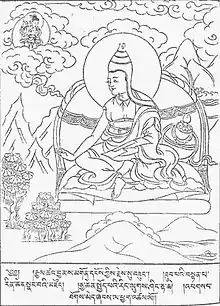Maitreya-nātha (c. 270–350 CE) is a name whose use was pioneered by Buddhist scholars Erich Frauwallner, Giuseppe Tucci, and Hakuju Ui to distinguish one of the three founders of the Yogacara school of Buddhist philosophy, along with Asanga and Vasubandhu.[1] Some scholars believe this Maitreya to be a historical person in India. The traditions themselves have held that it is referring to Maitreya, the future buddha.
Academic views
Scholars are divided in opinion whether the name refers to a historical human teacher of Asaṅga or to the bodhisattva Maitreya.[2] Frauwallner, Tucci and Ui proposed this as a possibility, while Eric Obermiller and Fyodor Shcherbatskoy doubted the historicity of this figure.[3]
Traditional view
The Buddhist traditions themselves have always held that Asaṅga received the texts in question from Maitreya directly in the Tuṣita heaven. Asaṅga is said to have spent many years in intense meditation, during which time tradition says that he often visited Tuṣita to receive teachings from the Maitreya. Heavens such as Tuṣita are said to be accessible through meditation. Xuanzang tells the account of these events:[4]
In the great mango grove five or six li to the southwest of the city (Ayodhyā), there is an old monastery where Asaṅga Bodhisattva received instructions and guided the common people. At night he went up to the place of Maitreya Bodhisattva in Tuṣita Heaven to learn the Yogācārabhūmi-śāstra, the Mahāyāna-sūtra-alaṃkāra-śāstra, the Madhyānta-vibhāga-śāstra, etc.; in the daytime, he lectured on the marvelous principles to a great audience.
Confusion over the idea of "supernaturally" visiting heavens may be due to the unfamiliarity of scholars with the Indian concept of heavens as being accessible through samādhi. Other advanced meditators recorded similar experiences of visiting Tuṣita Heaven at night.[5] One such example of this is Hanshan Deqing during the Ming dynasty. In his autobiography, Hanshan describes the palace of Maitreya in Tuṣita, and hearing a lecture given by Bodhisattva Maitreya to a large group of his disciples.[6]
In a moment I saw that tall, dignified monks were standing in line before the throne. Suddenly, a bhikṣu, holding a sutra in his hands, came down from behind the throne and handed the sutra to me, saying, "Master is going to talk about this sutra. He asked me to give it to you." I received it with joy but when I opened it I saw that it was written in gold Sanskrit letters which I could not read. I put it inside my robe and asked, "Who is the Master?" The bhiksu replied, "Maitreya."
Hanshan Deqing recalls the teaching given as the following:[7]
Maitreya said, "Discrimination is consciousness. Nondiscrimination is wisdom. Clinging to consciousness will bring disgrace but clinging to wisdom will bring purity. Disgrace leads to birth and death but purity leads to Nirvana." I listened to him as if I were in a dream within the dream. His voice, like the sound of tinkling crystal, floated on the air. I could hear him so clearly that even when I awoke his words kept on repeating in my mind. Now I realized the difference between consciousness and wisdom. Now I realized also that the place where I had been in my dream was Maitreya Buddha's Chamber in Tushita Heaven.
Attributed works
The number of works attributed to him vary in the traditions of Tibetan Buddhism and Chinese Buddhism, but variously include:
- the Yogācārabhūmi śāstra, the encyclopaedic and definitive text of the Yogacara school
- the Mahāyānasūtrālamkārakārikā, which presents the Mahāyāna path from the Yogācāra perspective
- the Dharmadharmatāvibhāga, a short Yogācāra work discussing the distinction and correlation (vibhāga) between phenomena (dharma) and reality (dharmatā)
- the Madhyāntavibhāgakārikā, 112 verses that are a key work in Yogācāra philosophy
- the Abhisamayalankara, which summarizes the Prajnaparamita sūtras, which the Mādhyamaka school regards as presenting the ultimate truth
- the Ratnagotravibhāga, also known as the Uttāratantra śāstra, a compendium of the Buddha-nature literature
The last five works are often referred to collectively as the Five Dharmas of Maitreya, and their authorship is given variously to Maitreyanātha, Asaṅga or a combination thereof.
Notes
- ↑ Being as Consciousness: Yogācāra Philosophy of Buddhism. Tola, Fernando and Carmen Dragonetti. Motilal Banarsidass: 2004 pg xv
- ↑ La Vallée Poussin, Louis de, Abhidharmakosabhasyam, Vol.1, p.15, English translation by Leo M. Pruden, Asian Humanities Press, Berkeley, California: 1991
- ↑ Ashok Kumar Chatterjee; The Yogācāra Idealism, page 33.
- ↑ Rongxi, Li. The Great Tang Dynasty Record of the Western Regions., Numata Center, Berkeley, 1996, p. 153.
- ↑ Sangharakshita. The Eternal Legacy: An Introduction to the Canonical Literature of Buddhism, Windhorse Publications, Birmingham, 2006, p. 248
- ↑ Rev. Chuan Yuan (Ming Zhen) Shakya (tr.). "The Autobiography and Maxims of Master Han Shan".
- ↑ Rev. Chuan Yuan (Ming Zhen) Shakya (tr.). "The Autobiography and Maxims of Master Han Shan".
